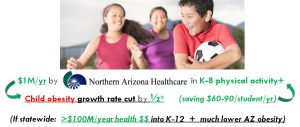In the HFAZ model, the health sector invests on a pay-for-performance basis, through a shared-governance intermediary, in more effective quality physical and nutrition education. This results in healthier children and families, rapid payback of investment, and high long-term ROI for health organizations and budgets. K-12 schools gain, by not only developing healthier students, but also improving academic achievement and student engagement—as increasing moderate-to-vigorous physical activity enhances cognition.

In the HFAZ model, the health sector invests on a pay-for-performance basis, through a shared-governance intermediary, in more effective quality physical and nutrition education. This results in healthier children and families, rapid payback of investment, and high long-term ROI for health organizations and budgets. K-12 schools gain, by not only developing healthier students, but also improving academic achievement and student engagement—as increasing moderate-to-vigorous physical activity enhances cognition.

Recent Comments